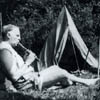Your shopping cart is empty!
Select currency
MENU

Cyril Power was born in London, the eldest child of an architect father, and a mother who encouraged the young CyrilPower's interest in the arts - in drawing in particular (there are sketchbooks which date back to 1886) but also in music, in the piano and violin - two instruments Cyril Power was to become proficient in playing.
Cyril Power followed in the family tradition, became an architect and worked in his father's practice. He excelled here, and in 1900 won The Sloane Medallion, awarded by the Royal Institute of British Architects (RIBA) for his design for an art school. He also wrote and published a three-volume work, illustrated with his drawings, on the ‘History of English Mediaeval Architecture'.
CyrilPower married Dorothy Mary Nunn in 1904 with whom he was to raise four children. They lived mostly in London - in Putney and then Catford - but for a period in Bury St. Edmunds, Suffolk, where Cyril Power was to meet and then work with life-long friend and fellow artist, Sybil Andrews.
Both artists, Power and Andrews, moved to London and in 1925 they helped Iain McNab and Claude Flight set up The Grosvenor School of Modern Art in Warwick Square. Andrews become the School Secretary, and Cyril Power the principle lecturer. He taught on the form and structure of buildings; on historical ornament and on architectural styles. But he, along with Andrews, also attended Claude Flight's classes, at the School, in linocutting.
Soon it was this medium, linocutting, which, with Claude Flight's ability both as supreme exponent of the art, and as teacher, attracted the (now famous) ‘Grosvenor' artists from far and wide - most notably, due to advertisements in ‘The Studio', from Australia and New Zealand.
The ‘First Exhibition of British Lino-Cuts' was mounted in June 1929 at The Redfern Gallery, London, and a series of exhibitions were then held annually at both The Redfern and The Ward Gallery. These attracted considerable interest, and commissions for Power's and Andrew's work come in from The London Passenger Transport Board. A series of prints were created on the theme: sporting venues reached by the Underground, and the prints were all signed ‘Andrew Power'.
Architecture was the subject of most of Cyril Power's early linocuts, such as ‘At Lavenham' (1928) and ‘Westminster Cathedral' (1928); but with Power's and Andrew's posters on the sporting venues the interest in speed and movement in his work first became evident. This vorticist's concern, not only with speed and movement, but with the modern and the urban, Power was to develop further: in ‘Whence and Whither?', ‘The Merry-Go-Round' and in the exceptional ‘Tube Station' and ‘The Sunshine Roof' - amongst his best works - all ingredients are present.
Cyril Power continued to teach and work, in oils, principally, after World War Two, and produced some ninety paintings in the last years of his life. He died in London, May 1951.
British Museum, London; London Transport Museum; Museum of Modern Art, New York; Huntarian Art Gallery, Glasgow; National Art Gallery, New Zealand; Auckland City Art Gallery, Australia.
This is a Limited Edition Giclee Print by the artist Cyril Power 285mm x 320mm Ed..
£148.00 Ex Tax: £123.33
This is a Limited Edition Giclee Print by the artist Cyril Power360mm x 250mmEdition size ..
£148.00 Ex Tax: £123.33
This is a Limited Edition Giclee Print by the artist Cyril Power 218mm x 376mm Ed..
£138.00 Ex Tax: £115.00
This is a Limited Edition Giclee Print by the artist Cyril Power 250mm x 410mm Ed..
£148.00 Ex Tax: £123.33
This is a Limited Edition Giclee Print by the artist Cyril Power243mm x 455mmEdition size ..
£138.00 Ex Tax: £115.00
This is a Limited Edition Giclee Print by the artist Cyril Power 243mm x 492mm Ed..
£138.00 Ex Tax: £115.00
This is a Limited Edition Giclee Print by the artist Cyril Power240mm x 345mmEdition size ..
£148.00 Ex Tax: £123.33
This is a Limited Edition Giclee Print by the artist Cyril Power 430mm x 386mm Ed..
£148.00 Ex Tax: £123.33
This is a Limited Edition Giclee Print by the artist Cyril Power 433mm x 483mm Ed..
£148.00 Ex Tax: £123.33
This is a Limited Edition Giclee Print by the artist Cyril Power 390mm x 370mm Ed..
£148.00 Ex Tax: £123.33
This is a Limited Edition Giclee Print by the artist Cyril Power 222mm x 453mm Ed..
£148.00 Ex Tax: £123.33
This is a Limited Edition Giclee Print by the artist Cyril Power 220mm x 455mm Ed..
£148.00 Ex Tax: £123.33
This is a Limited Edition Giclee Print by the artist Cyril Power 335mm x 430mm Ed..
£148.00 Ex Tax: £123.33
This is a Limited Edition Giclee Print by the artist Cyril Power 575mm x 320mm Ed..
£148.00 Ex Tax: £123.33
This is a Limited Edition Giclee Print by the artist Cyril Power 395mm x 408mm Ed..
£148.00 Ex Tax: £123.33
This is a Limited Edition Giclee Print by the artist Cyril Power 400mm x 310mm Ed..
£175.00 Ex Tax: £145.83